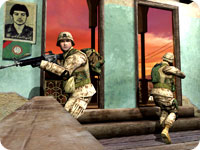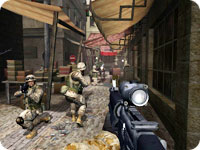Multiplayer Modes
Once you’ve mastered the single-player missions, test your skills against other players over a LAN or head to the Internet with the built-in GameSpy technology, which allows you to play against other gamers whether they’re on PCs or Macs. First to Fight offers two main multiplayer modes: cooperative, in which the players take on the different RTFA roles and play through the single-player missions; and Fire Team Arena, which pits two RTFA teams against each other in one of eight maps designed specifically for that purpose.
You can also modify the cooperative game and allow players to choose weapons different from the ones typically issued. In Fire Team Arena, you can tweak the number of lives given to each team, the overall kill limit or the time limit and use one or more of those criteria to decide when the game ends. Fire Team Arena players can also select their own weapons.

We're Going the Other Way. Must be a multiplayer moment, because no AI marine would head in the wrong direction during a mission.

The original insurgents — rising up against the original British rule in the American revolution — the U.S. Marine Corps was formed on Nov. 10, 1775 by a resolution of the Continental Congress. Members of the “Continental Marines” were recruited at a tavern in Philadelphia. The Continental Marines were disbanded in 1783, after the Revolutionary War ended, but were re-formed on July 11, 1798 by an act of Congress. Nov. 10, however, is considered the Marine Corps’ official birthday.
Close Combat: First to Fight derives its name from the idea that marines are always ready for action, which makes them suitable as the initial force sent into a combat zone. The Marine Corps distinguished itself in the 19th century by taking part in the Mexican-American War and deploying to such places as Korea, Cuba, the Philippines and China, although marines were used little during the Civil War.
World War I, however, cemented the Corps’ reputation for using tough, battle-tested troops who were unafraid to enter any situation, no matter how bleak. During the war, German soldiers nicknamed the marines “devil dogs,” a term proudly used today by marines to connote the fear they instill in the enemy.
World War II saw marines taking a prominent role in the battles against Japanese forces in the Pacific. One of the most famous photographs taken during any war depicted five marines and a Navy medical corpsman raising the U.S. flag on Mt. Suribachi during the Battle of Iwo Jima. Since then, marines have been used heavily in the Korean and Vietnam Wars and the current engagements in Iraq and Afghanistan as well as in smaller conflicts, such as the one in Bosnia in 1996.
First to Fight’s storyline, which Tamte describes as a “What if?”, sees the marines deployed to Beirut, Lebanon in 2006. The prime minister has been forced to leave the country to seek medical care, opening the way for heavy fighting between Lebanese Militia supported by Syrian forces and radical zealots known as Atash, who receive help from Iranian Special Forces.
NATO asks for U.S. assistance and the marines are sent into Lebanon, where they quickly secure Beirut’s main port, El Karantina, and use it as their main base of operations. From there, they must quell the violence between the factions, each of which controls a different part of Beirut. Success involves capturing or killing the men who lead the different factions, although your performance ratings receive a bigger boost from the former. Watch out for civilians roaming the streets, however: you must protect them as much as possible; if you accidentally kill too many of them, your mission will end.

The View From Here. A marine uses a building window to get a better look at the enemy.

Making a Move. The team effectively uses suppressing fire to move a man between positions.

The Market is Always Dead When This Happens. Use caution everywhere, even in civilian areas.
Flanking is an important technique, one that often surprises enemy fighters and can cause them to quickly surrender or run away. In a “fix and flank” maneuver, order your SAW gunner to distract the enemy with suppressing fire on their location, which fixes them in one spot while the rest of the team moves into a flanking position.
If possible, take a flanking position above the enemy, which forces them to contend with fire from multiple locations as well as multiple angles.- “Suppressing fire is the thing I’m hoping players will really grab onto quickly,” says Tamte, “because that is a powerful technique for covering your movement. You should have your SAW gunner do it whenever possible.”
- If your SAW gunner is killed or hurt too badly to continue the mission, make sure you take his weapon with you. His SAW machine gun should be an important component of your battle plan. You can also grab weapons and ammo from opposing forces after you defeat them.
- Remember that smoke grenades offer a great way to conceal your movement, especially if you’re forced into an entire area full of hostile forces. Seek cover while they’re blind.
- Never walk right into a room. Issue a take-down order, which directs your men to quickly storm the room and secure it. If you know enemies are behind the door, tell your team to lob grenades into the room before rushing into it.
- You can use the “Comply” command to direct all enemy forces in the area to surrender. They may not do so if their morale is high enough, but they may choose to flee instead. Remember, however, to secure all surrendered enemies so they can’t get a morale boost and attack your team.
- There is usually more than one route through a level. If the obvious way looks too difficult, try to find an alternate.
- Surprise the enemy whenever possible. This will cause their psychology model to devolve into a state of panic, if you keep a steady barrage of fire on their position.
- Target enemy leaders first. Without them, enemy troops will quickly lose morale and discipline.
- Sometimes you may come across opposing factions engaged in a battle against each other. Stay out of the way and wait for them to finish, then move in on the winner.
- The “combined arms” technique calls for hitting the enemy with a dilemma, such as suppressing fire from one direction while you lob a grenade into their position from another. Do they run from the grenade into the suppressing fire, or sit tight and take their chances? This technique enables you to push the enemy in a specific direction; use it in conjunction with your MAGTF assets for greater effect.
- Be aware of your teammates’ movements during combat to avoid friendly fire accidents. Marines shout “Red!” when they’re reloading and “Green!” when they’re finished. Keep an ear open and provide supporting fire against the enemy when a fellow marine has stopped to reload.
- If your team has a situation under control, look around for enemy troops trying to use flanking or other maneuvers. Don’t keep your entire focus on an immediate threat and lose sight of the bigger picture.
- Mac OS X version 10.2.8
- 867MHz PowerPC G4 processor
- 256MB of RAM
- 32MB video card (Radeon 7500, NVidia GeForce 2MX or better)
- 2.5GB hard disk space
- DVD drive
- Internet play requires broadband connection
